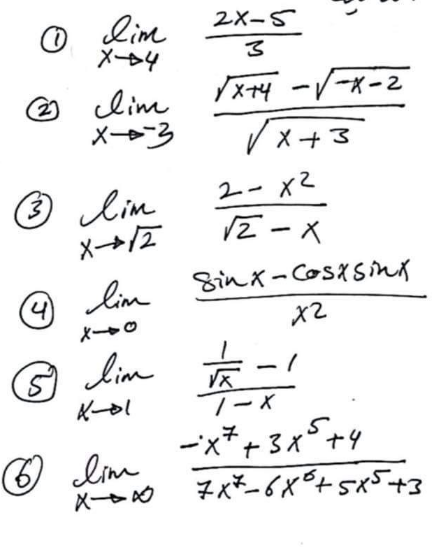Question Number 134006 by mohammad17 last updated on 26/Feb/21

Answered by malwan last updated on 26/Feb/21

$$\left(\mathrm{1}\right)\:\underset{{x}\rightarrow\mathrm{4}} {{lim}}\:\frac{\mathrm{2}{x}−\mathrm{5}}{\mathrm{3}}\:=\:\frac{\mathrm{2}×\mathrm{4}−\mathrm{5}}{\mathrm{3}}\:=\:\mathrm{1} \\ $$$$\left(\mathrm{2}\right)\:\underset{{x}\rightarrow−\mathrm{3}^{+} } {{lim}}\:\frac{\sqrt{{x}+\mathrm{4}}\:−\sqrt{−{x}−\mathrm{2}}}{\:\sqrt{{x}+\mathrm{3}}}×\frac{\sqrt{{x}+\mathrm{4}}\:+\:\sqrt{−{x}−\mathrm{2}}}{\:\sqrt{{x}+\mathrm{4}}\:+\:\sqrt{−{x}−\mathrm{2}}} \\ $$$$=\:\underset{{x}\rightarrow−\mathrm{3}^{+} } {{lim}}\:\frac{\mathrm{2}\:\sqrt{{x}+\mathrm{3}}\:\sqrt{{x}+\mathrm{3}}}{\:\sqrt{{x}+\mathrm{3}}\left(\sqrt{{x}+\mathrm{4}}\:+\sqrt{−{x}−\mathrm{2}}\right)}=\mathrm{0} \\ $$$${but}\:\underset{{x}\rightarrow−\mathrm{3}^{−} } {{lim}}\:{doesn}'{t}\:{exist} \\ $$$$\left(\mathrm{3}\right)\:\underset{{x}\rightarrow\sqrt{\mathrm{2}}} {{lim}}\:\frac{\mathrm{2}−{x}^{\mathrm{2}} }{\:\sqrt{\mathrm{2}}−{x}}\:=\underset{{x}\rightarrow\sqrt{\mathrm{2}}} {{lim}}\:\frac{\left(\sqrt{\mathrm{2}}+{x}\right)\left(\sqrt{\mathrm{2}}−{x}\right)}{\:\sqrt{\mathrm{2}}−{x}}\:=\mathrm{2}\sqrt{\mathrm{2}} \\ $$$$\left(\mathrm{4}\right)\:\underset{{x}\rightarrow\mathrm{0}} {{lim}}\:\frac{{sinx}−{cosxsinx}}{{x}^{\mathrm{2}} } \\ $$$$=\:\underset{{x}\rightarrow\mathrm{0}} {{lim}}\:\frac{{sinx}\left(\mathrm{1}−{cosx}\right)}{{x}^{\mathrm{2}} }\:=\:\underset{{x}\rightarrow\mathrm{0}} {{lim}}\frac{{sinx}×\mathrm{2}{sin}^{\mathrm{2}} \frac{{x}}{\mathrm{2}}}{{x}^{\mathrm{2}} } \\ $$$$=\:\mathrm{0} \\ $$$$\left(\mathrm{5}\right)\:\underset{{x}\rightarrow\mathrm{1}} {{lim}}\:\frac{\frac{\mathrm{1}}{\:\sqrt{{x}}}−\mathrm{1}}{\mathrm{1}−{x}}\:=\underset{{x}\rightarrow\mathrm{1}} {{lim}}\:\frac{\frac{\mathrm{1}−\sqrt{{x}}}{\:\sqrt{{x}}}}{\left(\mathrm{1}+\sqrt{{x}}\right)\left(\mathrm{1}−\sqrt{{x}}\right)} \\ $$$$=\:\frac{\mathrm{1}}{\mathrm{2}} \\ $$$$\left(\mathrm{6}\right)\:\underset{{x}\rightarrow\infty} {{lim}}\:\frac{−{x}^{\mathrm{7}} +\mathrm{3}{x}^{\mathrm{5}} +\mathrm{4}}{\mathrm{7}{x}^{\mathrm{7}} −\mathrm{6}{x}^{\mathrm{6}} +\mathrm{5}{x}^{\mathrm{5}} +\mathrm{3}}\:=\:−\frac{\mathrm{1}}{\mathrm{7}} \\ $$
